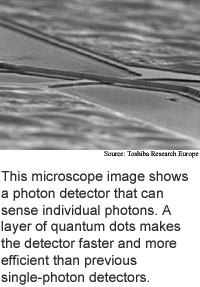
Speedy photon detector debuts
By
Eric Smalley,
Technology Research NewsThe human eye is sensitive enough to detect a few or even single photons of light. Many groups of researchers have been working on devices designed to automatically detect individual photons quickly and efficiently.
Improving single photon detection would improve medical imaging and diagnosis, chemical analysis, laser ranging and timing, sensing applications, fiber optic testing, and quantum cryptography. Quantum cryptography is a method of sending secure encryption codes using the properties of photons to represent the ones and zeros of digital information.
Researchers from Toshiba Research Europe and the University of Cambridge have devised a fast, efficient photon detector that senses individual photons. "We have invented a new type of detector which responds to individual photons -- the particles of light," said Andrew Shields, a group leader at Toshiba Research.
A candle produces about one billion billion photons per second.
The researchers' device is a semiconductor resonant tunneling diode that contains a layer of quantum dots. A resonant tunneling diode limits electrical current to one direction and to discrete amounts. Quantum dots are nanoscale bits of semiconductor that act like artificial atoms, trapping one or a few electrons. The quantum dots used by the device measure 30 nanometers wide and eight nanometers tall, or more than two orders of magnitude smaller than a red blood cell. A nanometer is one millionth of a millimeter.
When a single hole, or positive charge left by the absence of a negatively-charged electron, is excited by a single photon, the hole combines with and so neutralizes an electron trapped in one of the quantum dots. "The capture of a hole excited by the photon by one of the dots can switch the magnitude of the current flowing through device," said Shields. This increase in the amount of current flowing through the device can be sensed, allowing the photon to be detected.
The photon detector is faster and more efficient than existing single photon detectors that use transistors, including a combination transistor-quantum dot device previously demonstrated by the researchers, said Shields. The prototype has an efficiency of 12.5 percent and can detect a new photon every 150 nanoseconds, or billionths of a second, giving the device a theoretical data rate of 5 megahertz.
This is faster and an order of magnitude more efficient than the researchers' transistor-based quantum dot device, said Shields. Existing detectors, which make single photons trigger avalanches of electrons, have higher efficiencies but are slower and more prone to noise.
Making the resonant tunneling diode detector's layers thinner and applying an antireflection coating could boost the device's efficiency to 65 percent and its speed as high as 100 megahertz, according to the researchers.
"We are particularly interested in using the device for quantum cryptography," said Shields. The researchers recently demonstrated a quantum key distribution system using conventional single photon detectors that secured a video conferencing transmission. "We plan to incorporate the quantum dot resonant tunneling diode detector, which will further enhance the key exchange rate," he said.
Quantum cryptography techniques that use single photons to represent each bit of information are theoretically perfectly secure because information can be stored in a photon in one of two ways, and it is only possible to read the information stored in one way before the photon is destroyed. If an eavesdropper intercepted a key and tried to send duplicate photons on to the recipient, the eavesdropper would have to guess at half of the bits and it would be apparent to the sender and receiver that the key was compromised because a large percentage would be different from those sent.
The device is especially appropriate for quantum cryptography applications because it has a very low dark count, or false positive rate, said Shields.
The photon detector could be ready for practical use in two to three years, said Shields.
Shields' research colleagues were James Blakesley of Toshiba Research Europe and the University of Cambridge, Patrick See and B. E. Kardynal of Toshiba Research Europe, and P. Atkinson, I. Farrer and D. A. Ritchie of the University of Cambridge. The work appeared in the February 18, 2005 issue of Physical Review Letters. The research was funded by the Engineering and Physical Sciences Research Council (EPSRC) and the European Union.
Timeline: 1-3 years
Funding: Government
TRN Categories: Optical Computing, Optoelectronics and Photonics; Quantum Computing and Communications
Story Type: News
Related Elements: Technical paper, "Efficient Single Photon Detection by Quantum Dot Resonant Tunneling Diodes," Physical Review Letters, February 16, 2005
Advertisements:
June 1/8, 2005
Page One
Stories:
Camera sees behind objects
Movie captures trapped light
Speedy photon detector debuts
How It Works: Computer displays
Briefs:
Going nano boosts thermoelectrics
Magnetic resonance goes nano
Lasers built into fiber-optics
Nano LEDs made easier

News:
Research News Roundup
Research Watch blog
Features:
View from the High Ground Q&A
How It Works
RSS Feeds:
News
Ad links:
Buy an ad link
| Advertisements:
|
 |
Ad links: Clear History
Buy an ad link
|
TRN
Newswire and Headline Feeds for Web sites
|
© Copyright Technology Research News, LLC 2000-2006. All rights reserved.